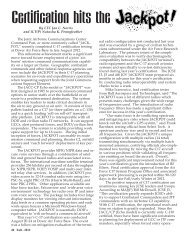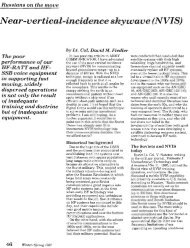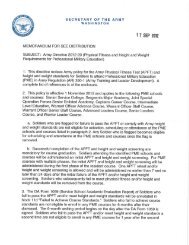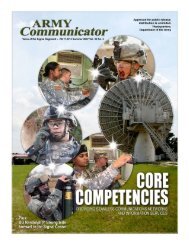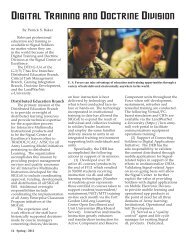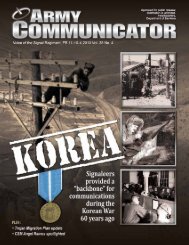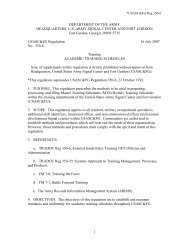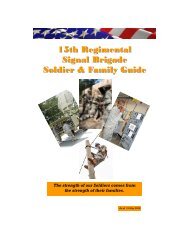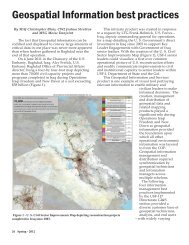AC Summer 08 WIN-T Online - United States Army Signal Center of ...
AC Summer 08 WIN-T Online - United States Army Signal Center of ...
AC Summer 08 WIN-T Online - United States Army Signal Center of ...
Create successful ePaper yourself
Turn your PDF publications into a flip-book with our unique Google optimized e-Paper software.
cut sheets, transmission plans,<br />
overall SATCOM subject matter<br />
expertise, national tier 2 architecture,<br />
and New Equipment Training<br />
augmentation for all fielding events.<br />
Beginning in 20<strong>08</strong>, the Inc 1 fielding<br />
hub will also support Inc 1 reset<br />
events.<br />
NSC-T establishment<br />
In fiscal year 2005, the BCBL(G)<br />
identified a sustainment training<br />
shortfall for <strong>WIN</strong>-T Inc 1 equipped<br />
units which included the lack <strong>of</strong><br />
bandwidth and a training support<br />
facility for post-fielding training. In<br />
addition, a facility was needed to<br />
provide TDMA hub support and<br />
GIG services for the continued Inc 1<br />
fielding, resetting units, and units<br />
without organic TacHubs. On Feb.<br />
2, 2006, BG Jeffrey W. Foley, as the<br />
CIO/G6 Architecture, Operations,<br />
Network and Space director, approved<br />
the concept <strong>of</strong> the Network<br />
Service <strong>Center</strong>-Training and provided<br />
funding for its establishment<br />
at BCBL(G). The NSC-T came online<br />
on May 15, 2006, and reached Final<br />
Operation Capability on Dec. 1,<br />
2006. It emulates the role <strong>of</strong> either<br />
the Tactical Hub or the Fixed Regional<br />
Hub Node and supports<br />
sustainment/pre-deployment<br />
training for JNN-equipped, JNNcompatible,<br />
and Marine Corps<br />
Support Wide Area Network units in<br />
Continental <strong>United</strong> <strong>States</strong>/Hawaii/<br />
Alaska on a 24x7x365 basis. Supported<br />
training includes home<br />
station training events, Combat<br />
Training <strong>Center</strong> rotations, <strong>Signal</strong><br />
<strong>Center</strong> resident training, and<br />
Capstone exercises. Training units<br />
connect to the NSC-T over one <strong>of</strong><br />
two satellites and access Non-secure<br />
Internet Protocol Router Network,<br />
Secure Internet Protocol Router<br />
Network, and Defense Switched<br />
Network from the Global Information<br />
Grid. To date, the NSC-T has<br />
performed over 300 training missions<br />
and currently averages 20<br />
missions per month.<br />
In addition to the core training<br />
hub mission, the NSC-T also plays<br />
pivotal roles in experimentation and<br />
prototyping <strong>of</strong> new technology/<br />
waveforms; tactic, technique and<br />
The NSC-T supports sustainment training for <strong>WIN</strong>-T Inc 1 equipped units<br />
in CONUS, Hawaii, and Alaska.<br />
Procedure; Detailed Technical<br />
Procedure development; and<br />
support to the SIGCEN resident<br />
schoolhouse. The NSC-T is slated to<br />
be a key participant in the upcoming<br />
<strong>WIN</strong>-T Inc 1b/Inc 2 Limited Users<br />
Test.<br />
Modeling and simulation support<br />
Since 2005, the BCBL(G)<br />
Modeling and Simulation Branch has<br />
supported PM <strong>WIN</strong>-T with Information<br />
Exchange Requirements and<br />
model-ready network traffic databases<br />
for input to the General<br />
Dynamics <strong>WIN</strong>-T model developed<br />
in the OPNET modeling environment.<br />
The traffic supports all phases<br />
<strong>of</strong> the acquisition life cycle and is<br />
based on approved operational<br />
requirements products. The Information<br />
Exchange Requirement and<br />
traffic databases reflect voice, video,<br />
and data IERs, with emphasis in<br />
FY<strong>08</strong> on improved collaboration<br />
exchanges, NetOps, applications<br />
data, and voice for legacy and FCS<br />
networks. The PM <strong>WIN</strong>-T modeling<br />
and simulation multi-year program<br />
is scheduled to continue through<br />
2011.<br />
Ongoing experimentation/assessments<br />
The BCBL(G) continues to<br />
conduct experiments and technology<br />
assessments that are relevant to the<br />
<strong>WIN</strong>-T program and warfighter<br />
capability gaps. This year, the<br />
BCBL(G) conducted the Medical<br />
Command-over-Joint Network Node<br />
experiment which assessed the<br />
ability <strong>of</strong> <strong>WIN</strong>-T Inc 1 to support<br />
<strong>Army</strong> Medical Department’s Information<br />
Exchange Requirements at<br />
the combat support hospital and<br />
medical company. The BCBL(G)<br />
recently completed an assessment <strong>of</strong><br />
the Linkway S2 TDMA satellite<br />
modem which is the follow-on<br />
product for the current Linkway<br />
2100 modem used in Inc 1. An<br />
assessment <strong>of</strong> the L3 MPM-1000<br />
Network-Centric Waveform modem<br />
which is scheduled to be inserted<br />
into the Inc 1b architecture is<br />
planned. Previous experiments<br />
include an MBCOTM experiment<br />
(FY06) which investigated and<br />
validated emerging on-the-move<br />
antenna and modem technologies.<br />
The Battle Lab also completed the<br />
TS/SCI-over-JNN experiment (FY07)<br />
which evaluated the technical<br />
feasibility <strong>of</strong> a JNN-equipped BCT to<br />
<strong>Army</strong> Communicator 55



